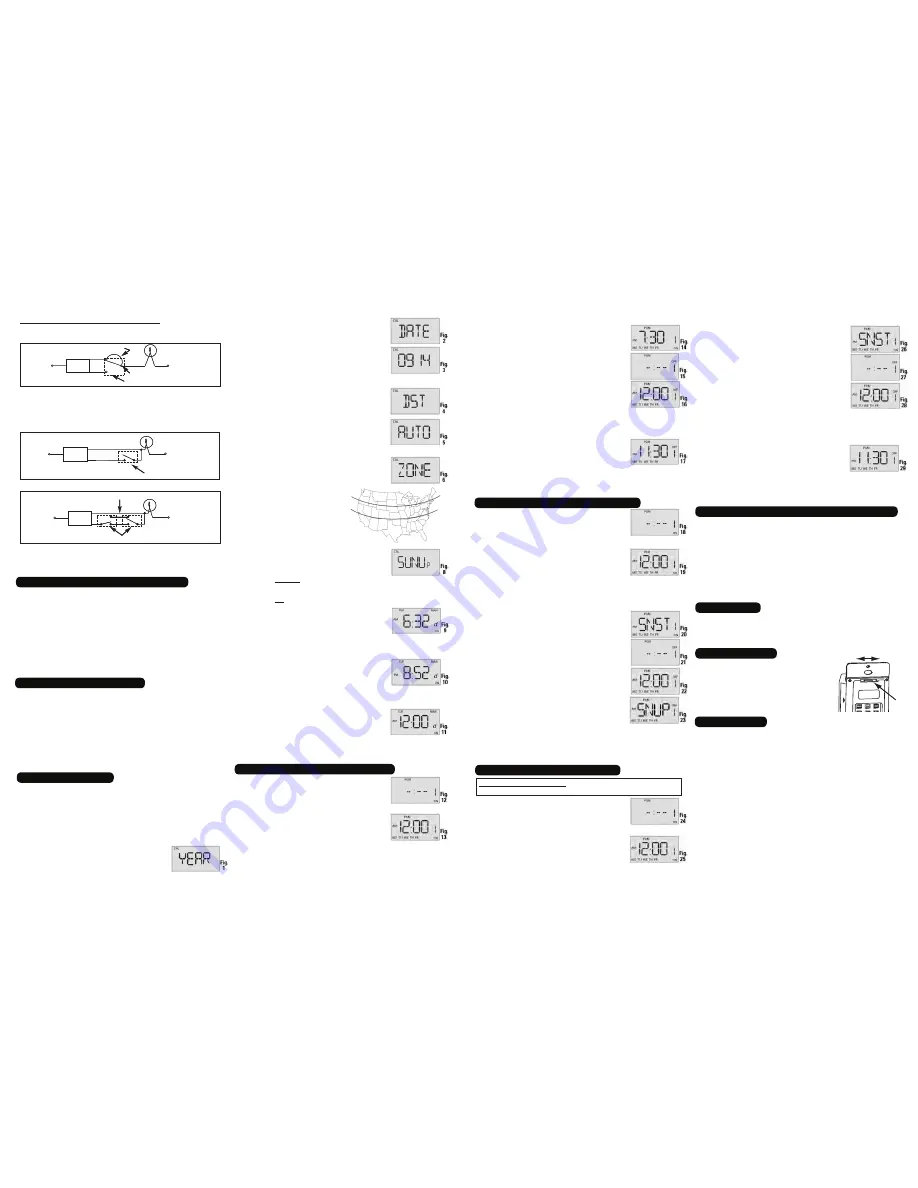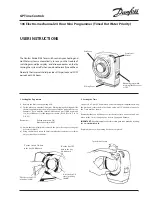
Press
HOUR+
to set the hour you want the program to turn ON.
Press
M+
to set the minutes you want the
program to turn ON (Fig. 14).
Press
NEXT ON/OFF
to set the OFF time for the
program. The screen again displays blanks
(Fig. 15).
Press
DAY/DST
as many times as necessary to
display 12:00 a.m. and the day(s) you want
the program to activate (Fig. 16).
NOTE:
Since you’re setting an OFF time for an
ON event already programmed, choose the
same days as in the ON event.
Press
HOUR+
to set the hour you want the program to turn
OFF.
Press
M+
to set the minutes you want the
program to turn OFF (Fig. 17).
At this point you have two choices:
Press
MODE
if you are finished to exit from programming.
Press
NEXT ON/OFF
to set another program. Repeat from
Step
2
above.
1.
2.
4.
1.
1.
2.
4.
-
-
As you press the buttons to program, it will be helpful to have
an overview of how they are organized. Press the
MODE
button
to rotate through the switch timer’s modes: CALendar, CLocK,
ProGraM, AUTO, AUTORANDom, and MANual.
Within each mode, menus “loop”, so they repeat when you
get to the end.
You must set the CALendar and CLocK before programming
ON/OFF times.
If you’re interrupted during programming, your work to that
point is automatically saved after 5 minutes.
•
•
•
•
3 – Intro to Programming: Read Before You Begin
5 – Set the Date and Time
Fig. 8
Fig. 7
South
North
Center
North
Center
South
It’s unlikely that the new switch timer has any existing program-
ming but to make sure, use this procedure
before setting the time.
Open the front cover.
Press the
RESET
button while holding down the
NEXT ON/OFF
button.
Release the
RESET
button. The screen will initialize, then flash
“12:00 am” in MANual mode.
Release the
NEXT ON/OFF
button.
All previous settings are now deleted.
1.
2.
3.
4.
4 – Clear Any Existing Programming
Press
NEXT ON/OFF
to display the date. The
word DATE and a number will be flashing
(Fig. 2).
Press
M+
to stop the flashing. Press again as
necessary to display the correct month (Fig. 3).
Press
DAY/DST
as necessary to display the cor-
rect date (Fig. 3). The correct day of the week
is shown as well.
Press
NEXT ON/OFF
to set Daylight Saving Time
(DST). The display flashes between DST and
AUTO (Fig. 4).
Press
DAY/DST
to stop the flashing. Press again
to toggle between AUTO and MAN for wheth-
er you want to adjust automatically for DST.
If your area uses DST, select AUTO (Fig. 5).
If your area does not use DST, select MAN.
Press
NEXT ON/OFF
to to set your ZONE. The
display flashes between ZONE and CENTr
(Fig. 6). This feature tracks changes in sunrise
and sunset times.
Press
ZONE+
to stop the flash-
ing. Press again to toggle
between SOUTh, NORTh,
and CENTr. Use the map (Fig.
7) to determine your zone.
Press
NEXT ON/OFF
to set exact
sunup and sunset times. The
display flashes between SUNUp and an AM
time (Fig. 8). Find the exact times in your area
in your newspaper or online.
If you DO NOT want to set exact Sunup and Sunset times:
Press
NEXT ON/OFF
to advance to SNSEt.
If you DO want to set exact Sunup and Sunset times:
Press
HOUR+
as necessary to set the cor-
rect SUNUp hour (Fig. 9).
NOTE:
The small letter “d” tells you that
Daylight Saving Time is in effect.
Press
M+
as necessary to set the correct minute.
Press
NEXT ON/OFF
to advance to setting exact SNSEt time
(Fig. 10).
Press
HOUR+
as necessary to set the cor-
rect SNSEt hour.
Press
M+
as necessary to set the correct SNSEt minute.
Setting the Calendar is complete. Now set Time of Day.
Press
MODE
to display CLK (clock) and a time.
The first time, 12:00 am will flash (Fig. 11).
Press
HOUR+
to stop the flashing.
Press
HOUR+
and
M+
to set the correct time.
NOTE:
Make sure AM or PM is correct.
Time and Date are now set. You can program ON/OFF settings.
3.
1.
2.
3.
6.
-
-
7.
6.
7.
-
a.
-
a.
a.
b.
c.
d.
1.
2.
3.
The two LR44/SR44 alkaline batteries maintain calendar and
time settings during power interruptions for up to 3 months
of accumulated interruptions.
All other settings remain in
memory indefinitely without batteries or AC power.
Remove batteries if the switch timer will be without AC power
for an extended time.
Replace the batteries if the display is dim or displays “lobAT”.
Batteries may be changed without removing AC power.
If AC power is removed, swap batteries within 15 seconds to
avoid losing time-of-day and calendar settings.
Remove the battery holder by prying left and right of the holder
with the tip of a flat screwdriver, then pry the battery holder up.
Install new batteries in the battery holder as marked, then
place it back into the switch timer with notch down.
If the display flashes “12:00,” reset time and check the date.
•
•
•
•
•
•
•
•
About the Battery
Once set up, you have three choices for using the switch timer.
To make a selection, open the front cover and press the
MODE
button until you see your choice of the following options:
AUTO
— uses the timer settings you have programmed.
AUTO RANDom
— gives your home a “lived-in” look by vary-
ing your settings by a random amount of ± 20 minutes or so.
MANual
— maintains your settings but operates the switch
timer like a standard ON/OFF. Press on the door of the switch
timer for ON, press again for OFF.
•
•
•
7 – Selecting AUTO, AUTO RANDom, or MANual Operation
Wiring Diagrams for Multiple Switch Timer Setups:
For a two-switch setup (3-way) when reusing the existing 3-way
remote switch:
NOTE:
For new construction or to replace a dimmer switch, a
lighted switch, or a 3-way switch without screw terminals, a
single-pole switch can be used at the remote location, as shown
below.
For a two-switch setup (3-way) using single-pole remote switch:
For a three-switch setup:
For four or more switch setups:
Use the preceding 3-switch installation diagram and wire 4-way
switches between the two 3-way switches.
LINE
BLACK
TIMER
BLUE
RED
JUMPER
LOAD
NEUTRAL
COMMON
3-WAY SWITCH
LINE
BLACK
TIMER
BLUE
RED
JUMPER
LOAD
NEUTRAL
COMMON
3-WAY SWITCH
BLACK
BLUE
LOAD
NEUTRAL
RED
TIMER
LINE
SINGLE-POLE SWITCH
BLACK
BLUE
LOAD
NEUTRAL
RED
TIMER
LINE
SINGLE-POLE SWITCH
ADDITIONAL WIRE
LOAD
NEUTRAL
TWO 3-WAY SWITCHES
RED
BLUE
TIMER
BLACK
LINE
ADDITIONAL WIRE
LOAD
NEUTRAL
TWO 3-WAY SWITCHES
RED
BLUE
TIMER
BLACK
LINE
6b – Set an ON/OFF Program for Sunrise/Sunset
Press
MODE
until the screen displays PGM
with blanks for time (Fig. 18).
Press
DAY/DST
as many times as necessary to
display 12:00 a.m. and the day(s) you want
the program to activate. Choices are:
everyday
weekdays only (Fig. 19)
weekends only
a specific day
NOTE:
If you go too far, keep pressing
DAY/DST
to loop back
around again.
Press
HOUR+
to select SNST (sunset) or SNUP
(sunup) for turning the program ON (Fig. 20).
Press
NEXT ON/OFF
to set the OFF time for the
program. The screen again displays blanks
(Fig. 21).
Press
DAY/DST
as many times as necessary to
display 12:00 a.m. and the day(s) you want
the program to activate (Fig. 22).
NOTE:
Since you’re setting an OFF time for an
ON event already programmed, choose the
same days as in the ON event.
Press
HOUR+
to select SNST (sunset) or SNUP
(sunup) for turning the program OFF (Fig. 23).
At this point you have two choices:
Press
MODE
if you are finished to exit from programming.
Press
NEXT ON/OFF
to set another program. Repeat from
Step
2
above.
1.
2.
-
-
-
-
1.
4.
1.
1.
4.
-
-
NOTE:
If you go too far, keep pressing
DAY/DST
to loop back
around again.
Press
HOUR+
to select SNST (sunset) for turning
the program ON (Fig. 26).
Press
NEXT ON/OFF
to set the OFF time for the
program. The screen again displays blanks
(Fig. 27).
Press
DAY/DST
as many times as necessary to
display 12:00 a.m. and the day(s) you want the
program to activate (Fig. 28).
NOTE:
Since you’re setting an OFF time for an
ON event already programmed, choose the same days as in
the ON event.
Press
HOUR+
to set the hour you want the program to turn
OFF.
Press
M+
to set the minutes you want the
program to turn OFF (Fig. 29).
At this point you have two choices:
Press
MODE
if you are finished to exit from programming.
Press
NEXT ON/OFF
to set another program. Repeat from
Step
2
above.
1.
4.
1.
1.
2.
4.
-
-
To override a program (ON/OFF time) till its next schedules time:
Press on the control cover (over the programming buttons)
Open the control cover and press the
NEXT ON/OFF
button.
•
•
Manual Override
In order for the switch timer to automatically adjust for seasonal
changes in sunrise and sunset, and change back and forth to
Daylight Saving Time, the CALENDAR must be set correctly.
NOTE:
If you go too far, keep pressing the button to loop back
around. For Year and Hour, you can also press the
YEAR- / HOUR-
button to back up.
Press
MODE
to display CAL and the year. The first time, the
word YEAR and a number will flash (Fig. 1).
Press
YEAR+
to stop the flashing. Press again
as necessary to display the correct year.
1.
2.
6a – Set an ON/OFF Program at Specific Times
Press
MODE
until the screen displays PGM
with blanks for time (Fig. 12).
Press
DAY/DST
as many times as necessary to
display 12:00 a.m. and the day(s) you want
the program to activate. Choices are:
everyday
weekdays only (Fig. 13)
weekends only
a specific day
NOTE:
If you go too far, keep pressing
DAY/DST
to loop back
around again.
1.
2.
-
-
-
-
6c – Setting Sunset ON/Specific Time OFF
Sunset ON / Specific Time OFF
is the most common setting for the
switch timer. As a convenience, here is the full step-by-step.
Press
MODE
until the screen displays PGM
with blanks for time (Fig. 24).
Press
DAY/DST
as many times as necessary to
display 12:00 a.m. and the day(s) you want
the program to activate. Choices are:
everyday
weekdays only (Fig. 25)
weekends only
a specific day
1.
2.
-
-
-
-
The manual “air gap” switch at he top
edge of the switch timer is designed to turn
power off for routine maintenance (e.g.,
repairs, removing broken bulbs, etc.). Using
this switch for normal ON/OFF operation
will shorten battery life.
The “Air Gap” Switch
ON
OFF




















